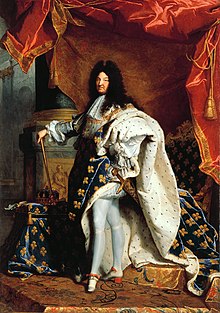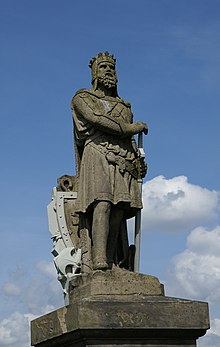ရာဇ






ရာဇ(ပါဠိ: Rāja) သို့မဟုတ် ဘုရင်(အင်္ဂလိပ်: King) အသုံးအနှုန်းသည် စိုးစံအုပ်ချုပ်သော ဘုရင် အမျိုးသားတစ်ဦးကို ခေါ်ဝေါ်သည့် စကားလုံးဖြစ်သည်။ အမျိုးသမီးအုပ်ချုပ်သူကို ဘုရင်မ (အင်္ဂလိပ်: queen) ဟူ၍ သုံးနှုန်းကြသည်။[၁] အင်္ဂလိပ် 'queen'.ဆိုသော စကားလုံးမှာ ဘုရင်တစ်ပါး၏ "မိဖုရား" ဟုလည်း ရည်ညွှန်းနိုင်သည်။
- သမိုင်းမတိုင်မီက ပေါ်ပေါက်လာသည့် ရှေးဟောင်းနှင့် ယနေ့ခေတ် ဌာနေတိုင်းရင်းသားများသည် မိမိတို့လူမျိုးစုခေါင်းဆောင်ကို မျိုးနွယ်စုဘုရင် (tribal king) အဖြစ် သတ်မှတ်ကြသည်။ ဂျာမန်နစ်ဘာသာစကားအရ "မင်း" သည် အင်ဒို-ယူရိုပီယန် ဘာသာစကားများပါ အုပ်ချုပ်မှုအစဉ်အလာဖြစ်သော မျိုးနွယ်စုအုပ်ချုပ်မှု ("မင်း/ဘုရင်) နှင့် ဘာသာဗေဒရင်းမြစ်အားဖြင့် တူညီလေသည်။ (ဥပမာ - အိန္ဒိယဘာသာစကားများတွင် ရာဇာ (rājan)၊ ဂေါ့သစ်ဘာသာတွင် "ရီးခ်စ်" (reiks) နှင့် ရှေးဟောင်းအိုင်းရစ် စကားတွင် "ရိ" (rí) စသဖြင့်) (မှတ်စု - "ရ" ရှာလိပ်သံဖြင့် ခေါ်ဆိုသည့် ဘာသာဗေဒ ရင်းမြစ် ဆက်စပ်မှု)
- ရှေးခေတ်ဂန္ထဝင်အရေးအသားတွင် ဘုရင်ကို လက်တင်ဘာသာတွင် "ရက်ကသတ်"နှင့် ဂရိတွင် "အာရခွန်" သို့မဟုတ် ဘာသိလိကောဟု ဘာသာပြန်ကြသည်။
- ဥရောပဂန္ထဝင်ပဒေသရာဇ်ခေတ်၌ ပြည့်ရှင်မင်း ရာထူးသည် အမြင့်ဆုံးဖြစ်ပြီး ဧကရာဇ်ဘွဲ့ကို (ရောမသမ္မတနိုင်ငံ နှင့် ရောမအင်ပါယာ ) တို့တွင် အသုံးပြုခဲ့သည်။ [၂]
- မျက်မှောက်ခေတ်အခြေအနေတွင် တံဆိပ်နာမံတော်ဘုရားသည် ဧကရာဇ်မင်းများ (အပြည့်အဝ သို့မဟုတ်ဖွဲ့စည်းပုံအခြေခံဥပဒေဆိုင်ရာ) အုပ်ချုပ်မှုကို ရည်ညွှန်းနိုင်သည်။ ရှင်ဘုရင်၏ တံဆိပ်နာမံတော်သည် ဧကရာဇ်အခြားတံဆိပ်နာမံတော်နဲ့တွဲ၍ အသုံးပြုနိုင်သည်။ အနောက်နိုင်ငံများတွင် ဧကရာဇ်၊ ခမ်းနားသည့်မင်းသား၊ မင်းသား၊ အက်ခ်မြို့စား၊, မြို့စားသို့မဟုတ် ခမ်းနားသည့်မြို့စားနှင့် အစ္စလာမ်လောကတွင် မာလစ် ၊ဆူလတန်, အာမီရာ၊ စော်ဘွား သို့မဟုတ် ဟာကမ်စသဖြင့်အသုံးပြုကြသည်။ [၃]
ဘုရင်ဆိုသည့်စကားလုံးကို ဘုရင့်ကြင်ယာတော်အတွက် တစ်ခါတစ်ရံတစ်ဦးအသုံးပြုလေ့ရှိသည်။ အစဉ်တော်ဘုရားဘွဲ့အရအာဏာရမိဘုရားဟု ခေါ်ဆိုနိုင်ပြီး တခါတရံမင်းသား၏ကြင်ယာတော်အား ပေးသနားပါသည်။
အင်္ဂလိပ်
[ပြင်ဆင်ရန်]အင်္ဂလိပ်စကားလုံး "ကင်း" သည် အင်္ဂလိပ်လို ဆက်ဆွန်စကား "ဆီနင်"မှ ဆင်းသက်လာခြင်းဖြစ်ပြီး ထိုစကားလုံးသည် ဂျာမန်စကား "ခုနင်ဂက်စ်"မှ တိုက်ရိုက်ဆင်းသက်လာခြင်းဖြစ်သည်။ ဂျာမန်အသုံးအနှုန်း "ခုနင်ဒက်စ်"ကို အစောပိုင်းအချိန်များတွင်အက်စ်တိုးနးယားနှင့်ဖင်လန်နိုင်ငံတို့က မွေးစားအသုံးပြုခဲ့ကြသည်။ အင်္ဂလိပ်"ကင်း" ဟူသောဝေါဟာရသည် လက်တင်စကားလုံး "ရက်ကသတ်" ညီမျှသောကြောင့် အခြားဥရောပစကားလုံးများသည်လည်း ဘာသာပြန်ဆိုကြသည်။ အခြားအင်ဒို-၊ အင်ဒို-ဥရောပဘာသာစကားများတွင် လက်တင်စကားလုံး "ရက်ကသတ်" ကို ဘာသာပြန်ဆိုရာ၌ "အုပ်စိုးသောမင်း" သို့ "ဘုရင်"ဟု စကားလုံးအနေဖြင့် အထူးကွဲပြားစွာပြန်ဆိုကြသည်။ လက်တင်စကားလုံးတွင် ရက်ကသတ်၊ သင်္သကရိုက်စကားလုံးတွင် ရာဇာန် အိုင်းရစ်စကားလုံးတွင် ရစ်ဂ်ဟု အသီးသီးရှိကြသော်လည်း ဂေါ့သစ်အဘိဓာန်တွင် "အခိုက်"ဟု တွေ့မြင်ရသည်။ လက်ရှိ ဂျာမန်စာတွင် "အခိုက်ချ်"၊ ဒတ်ခ်စ်စာပေတွင် "ရာအီ"ဟု ရေးသားနေကြသည်။ ကင်းသည် ရှေးအင်္ဂလိပ်စာ စင်န် ဟူသောဝေါဟာရမှ ဆင်းသက်လာသည် ။ စာသားအရအဓိပ္ပာယ်မှာ“ မြင့်မြတ်သောဆွေမျိုးသားချင်းများ” (သို့)“ မွေးဖွားသူတစ် ဦး မှဆင်းသက်လာသူ” ( OED ) ဖြစ်နိုင်သည်။
ကိုးကား
[ပြင်ဆင်ရန်]- ↑ There have been rare exceptions, most notably Jadwiga of Poland and Mary, Queen of Hungary, who were crowned as King of Poland and King of Hungary respectively during the 1380s.
- ↑ The notion of a king being below an emperor in the feudal order, just as a duke is the rank below a king, is more theoretical than historical. The only kingdom title held within the Holy Roman Empire was the Kingdom of Bohemia, with the Kingdoms of Germany, Italy and Burgundy/Arles being nominal realms. The titles of King of the Germans and King of the Romans were non-landed titles held by the Emperor-elect (sometimes during the lifetime of the previous Emperor, sometimes not), although there were anti-Kings at various points; Arles and Italy were either held directly by the Emperor or not at all. The Austrian and Austro-Hungarian Empires technically contained various kingdoms (Hungary, Bohemia, Dalmatia, Illyria, Lombardy–Venetia and Galicia and Lodomeria, as well as the Kingdoms of Croatia and Slavonia which were themselves subordinate titles to the Hungarian Kingdom and which were merged as Croatia-Slavonia in 1868), but the emperor and the respective kings were the same person. The Russian Empire did not include any kingdoms. The short-lived First French Empire (1804–1814/5) included a number of client kingdoms under Napoleon I, such as the Kingdom of Italy, the Kingdom of Westphalia, the Kingdom of Etruria, the Kingdom of Württemberg, the Kingdom of Bavaria, the Kingdom of Saxony and the Kingdom of Holland. The German Empire (1871-1918) included the Kingdoms of Prussia, Bavaria, Württemberg and Saxony, with the Prussian king also holding the Imperial title.
- ↑ Pine၊ L.G. (1992)။ Titles: How the King became His Majesty။ New York: Barnes & Noble။ p. 86။ ISBN 978-1-56619-085-5။
